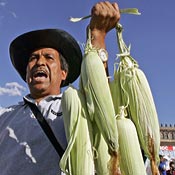As the Copenhagen Summit drew to a close, U.S. Secretary of State Hillary Clinton made a surprising announcement: the United States would raise $100 billon in annual aid for developing countries by 2020, and in return they “open their carbon-accounting book.” There was only one problem with this plan– Congress had not signed off on this promise. The U.S. needs the support of Congress for policy to be put in place to see the pledge through, and Clinton’s remarks were immediately met with opposition back in D.C. Now you may be wondering (along with your Congressmen) who will pay this $100 billion. Here is where this money could come from:
- Offset projects– projects, such as planting trees, that help to reduce carbon in the atmosphere
- In a cap and trade program, offsets could help companies meet emissions requirements
- The European Union already uses such a system
- Some taxes
This week, talks of the 2011 budget were abuzz at Capitol Hill. Among those discussions was environmental policy. Some of the things Obama is calling for in his budget are:
- Money for renewable energy research– solar, wind, and geothermal
- Expanding nuclear power
- Make cuts in tax breaks for large fossil fuel companies
Environmental policy is something that Americans will be hearing about more and more as our administration, along with leaders from around the world, work to improve our world.










